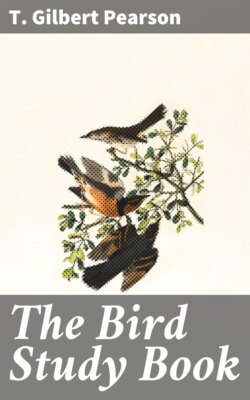Читать книгу The Bird Study Book - T. Gilbert Pearson - Страница 9
На сайте Литреса книга снята с продажи.
Sample page of reporting-blank
ОглавлениеTable of Contents
Bird Books.—There are a number of inexpensive books which contain illustrations of birds in natural colours. One of these will be of the greatest aid to the beginner in bird study. Among the most useful are the Reed's, "Bird Guides," one covering the birds of the eastern and the other those of the western part of the United States. The pictures alone will be of great use in learning the names of feathered neighbours, while an intelligent study of the text will reveal the identity of many others.
Local lists of such birds as are found in a neighbourhood, or a county, are always a great aid in determining, with a fair degree of accuracy, just what species may or may not be expected to appear in a given locality. Such lists are usually first published in The Auk, The Condor, or other ornithological publications, and in many cases are printed and distributed later as separate pamphlets.
There have been published also many State lists of birds, usually accompanied by detailed information regarding abundance and distribution of all the species known to occur in the State. Every bird student should, if possible, get a copy of his own State bird book. Any reader who may wish to learn if such a list of the birds of his neighbourhood or State has been published is at liberty to address the question to the author of this book.
Movements of Birds.—One does not get very far in the work of bird study without discovering that certain movements are characteristic of various families; and when the observer is able to recognize this difference in manner a long step has been taken in acquiring the power of identifying species.
After watching for a time the actions of a Downy Woodpecker as it clings to the side of a tree, or hops along its bark, one is quick to recognize the Woodpecker manner when some other species of that family is encountered. Recalling the ceaseless activities of a Yellow Warbler the observer feels, without quite knowing why, that he has discovered another Warbler of some kind when a Redstart or Chestnut-sided Warbler appears. Once identify a Barn Swallow coursing through the air, and a long stride is made toward the identification of the Cliff or Tree Swallow when one swings into view. The flight of the Flicker, the Goldfinch, the Nighthawk, and the Sparrow Hawk, is so characteristic in each case that I have often been able to name the bird for a student upon being told its approximate size and the character of its flight. Who can see a Wild Duck swimming, or a Gull flying, without at once referring it to the group of birds to which it belongs? Thus the first step is taken toward learning the names of the species, and the grouping of them into families.
Artificial Cover in Hiding.—When studying the larger or the shyer species it is sometimes well to hide one's self from view with whatever articles are at hand that resemble the natural surroundings. This may be done by covering with hay if in a field, or by holding some leafy branches about you if in the woods.
On a lonely island in Pamlico Sound I once got some fishermen to cover me with sand and sea-shells, and in that way managed to get a close view of the large flocks of Cormorants that came there to roost every night. The island was small and perfectly barren, and any other method of attempted concealment would have failed utterly.
Another time, while crouched among some boulders watching for a flock of Gambel's Quails to come to a water-hole in the Santa Catalina Mountains of Arizona, a Canyon Wren alighted on my back, for I was covered with an old tent fly so spotted with mildew that it closely resembled the neighbouring rocks. A moment later it flew to a point scarcely more than a foot from my face, when, after one terrified look, it departed.
